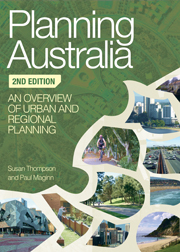Book contents
- Frontmatter
- Contents
- Contributors
- Figures and tables
- Discussion points and case studies
- Preface
- Acknowledgments
- Abbreviations
- Table of statutes
- Introduction
- Part I Frameworks
- 1 What is planning?
- 2 Planning and governance
- 3 Planning as a profession
- 4 An historical perspective
- 5 Statutory planning
- Part II Key Issues
- Index
- References
5 - Statutory planning
from Part I - Frameworks
- Frontmatter
- Contents
- Contributors
- Figures and tables
- Discussion points and case studies
- Preface
- Acknowledgments
- Abbreviations
- Table of statutes
- Introduction
- Part I Frameworks
- 1 What is planning?
- 2 Planning and governance
- 3 Planning as a profession
- 4 An historical perspective
- 5 Statutory planning
- Part II Key Issues
- Index
- References
Summary
Key terms: legislation; administration; statutes; environmental law; environmental planning law; land-use planning; strategic planning; statutory plans; development; development assessment; environmental impact assessment.
This chapter examines the statutory or legal framework in which planning takes place, both as a function of government and as an expression of public policy and social goals and aspirations. Indeed, legislation has a pivotal role in determining planning’s administrative and governance context, but it is important to understand that the context for planning varies according to jurisdiction. Therefore, the chapter compares the jurisdictional and legal characteristics of the different federal, state and territory planning systems in Australia, noting first that planning issues need to be considered in relation to environmental law across all jurisdictions. It then provides an overview of the administrative and jurisdictional characteristics of Australian planning systems, before arguing that the most significant areas of legislation from a planning point of view are:
strategic planning, statutory plans and plan-making
development assessment
environmental impact assessment
appeals and review
public participation.
Australia’s planning systems have been subject to ongoing reforms since the 1980s, and these are invariably reflected in and implemented through ongoing legislative change in the areas noted above. Trends, similarities and contrasts in different jurisdictions are analysed in relation to these recent changes and reform agendas. The chapter concludes with comment on future directions in the legislative frameworks of domestic planning systems.
- Type
- Chapter
- Information
- Planning AustraliaAn Overview of Urban and Regional Planning, pp. 98 - 124Publisher: Cambridge University PressPrint publication year: 2012
References
- 2
- Cited by



